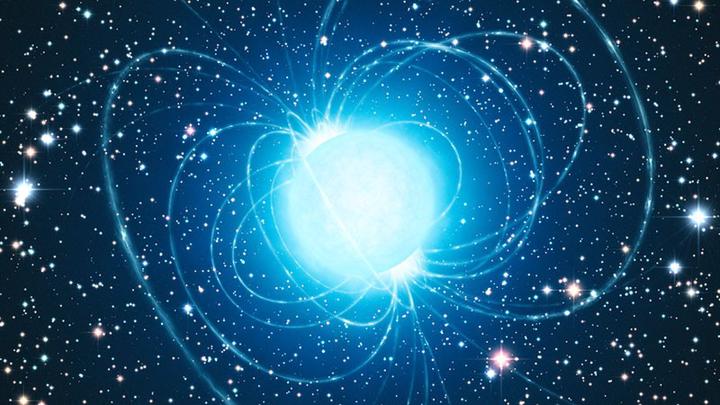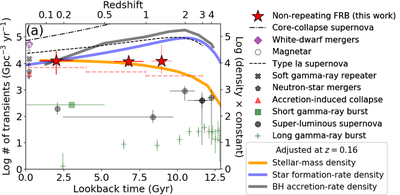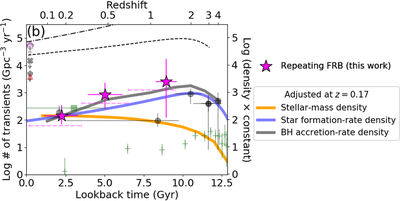 Image credit: [ESO/L. Calçada]
Image credit: [ESO/L. Calçada]
Fast radio bursts (FRBs) are mysterious short-time bursts in radio wavelength. Most of them emerge from extra-galaxies. Observationally, there are two types of FRBs, i.e., non-repeating and repeating ones. Recently one repeating FRB source was confirmed from a Galactic magnetar, SGR 1935+2154 . However, we do not know what the remaining more than 99% are.
To address this issue, I performed a statistical approach using number densities of FRBs.


I, for the first time, found that the number density (per unit time) of non-repeating FRBs is nearly constant over the past ~10 Gyr (=10 billion year) towards the distant Universe (red stars in panel a in Figure). The nearly-constant density is consistent with a flat trend of cosmic stellar-mass density traced by old stellar populations with ~Gyr time scales. This indicates that non-repeating FRBs originate from long-living objects, e.g., white dwarfs, neutron stars, and (stellar-mass) black holes.
In contrast, the number density of repeating FRBs (magenta stars in panel b in Figure) increases towards the distant Universe in a similar way to the cosmic star formation-rate density or super massive black hole accretion-rate density (activity of so-called active galactic nuclei). Short-living objects with ~Myr (=million year) time scales associated with (i) young stellar populations (or their remnants, e.g., supernova remnants, young pulsars, and magnetars) or (ii) active galactic nuclei are favoured as progenitor candidates of repeating FRBs.
This project is based on the following publication.
Tetsuya Hashimoto, Tomotsugu Goto, Alvina Y. L. On, Ting-Yi Lu, Daryl Joe D. Santos, Simon C.-C. Ho, Seong Jin Kim, Ting-Wen Wang, and Tiger Y.-Y. Hsiao, 'No redshift evolution of non-repeating fast radio-burst rates' , Monthly Notices of the Royal Astronomical Society, Volume 498, Issue 3, pp.3927-3945, (2020).
This paper was selected for a press release organized by the Astronomical Society of Japan, 15 March 2021. I won the best postdoc paper award in Taiwan 2020 selected by the Ministry of Science and Technology of Taiwan.
This paper was featured by NTHU 秘書處新聞稿 , しんぶん赤旗 , TUN大學網 , 產經新聞 , AstroArts , 産経新聞 , INQUIRER.net , NewsPicks , and The NTHU newsletter .